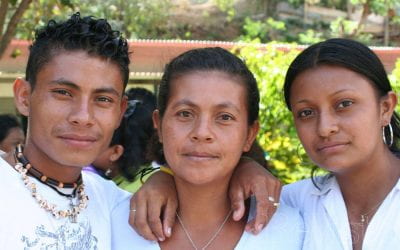In the Eye of the Beholder
Pursuing Quality in Latin America

Class at the Fundación Universitaria Claretiana (FUCLA) in Quibdó, El Chocó, Colombia. Photo by Steve Cagan.
It’s ridiculous to imagine that anyone would want poor quality from any product or service that they needed. So, not surprisingly, the many “consumers” of higher education want good, if not outstanding, quality as well. But what does that mean exactly? It’s relatively simple to define a good-quality automobile—comfortable, reliable, safe, efficient to operate. A good-quality meal—its taste, service, presentation, value. A good-quality computer—fast, doesn’t crash, easy to use, well designed. Consensus about the definition of quality for education in general, and higher education in particular, is more elusive. Is it about learning career skills? Learning life skills? Is it about finding a job upon graduation in the student’s field of study? Is it about having access to appropriate academic resources and technology?
The elusive definition of quality for higher education has stymied policymakers and scholars alike, yet, during the last several decades, most countries throughout the world have established quality assurance systems, even without reaching consensus about the meaning of quality. In other words, this would be like producing a car without being completely sure of what you want it to do on the road.
Despite the ambiguity of definition and goals, accreditation agencies along with new demands for accountability have been established throughout Latin America (as elsewhere) since the early 1990s. These new systems have emerged in response to pressure from the World Bank, as a reaction to public skepticism about university output and as a key mechanism for facilitating international collaborations. Today, quality assurance systems in the region are operating almost everywhere and are increasingly accepted for their inevitability and importance.
Accountability
Why the interest in accreditation and concern for greater accountability? In part, this is because Latin American nations, as most of the developing world, were facing dramatic changes in enrollment including growing graduation rates from secondary school—meaning more students aspiring to higher education—and a growing belief that higher education is the best way for individuals and societies to progress. This put considerable pressure on the limited capacity of governments and existing higher education institutions. Governments responded in different ways—increasing the enrollment at public universities, creating new public universities, removing barriers to the creation of private universities, permitting foreign universities to offer degree programs, and often, all of the above. The rapid growth of systems presented many new challenges.
With the emergence of so many new providers and increased access for students who did not belong to the traditional elites, quality became a growing concern. In many countries, institutions seemed to appear overnight, often referred to as “garage universities” because of their limited infrastructure and staff. Many of these new private academies operated for profit, with business targets given priority over educational objectives. The mounting prevalence of low-quality private providers and the increased number of students whose sole objective was a credential posed the risk of diluting the value of a university title.
By the end of the 1980s the university problem in many Latin American countries seemed out of control, to the dismay of an increasingly dubious public. Particularly concerning was the skepticism of employers who relied on a university degree as a validation of professional knowledge and preparation. Governments were not prepared for this new reality. Traditionally, ministries of education had limited their oversight to the review of degree requirements and setting qualifications and expectations for professors. This was no longer sufficient. Some governments responded with new regulations that failed because the muscle necessary to enforce them wasn’t there. The strict-regulation approach also butted against the huge wall of institutional autonomy, something considered sacrosanct by Latin American universities. The mere notion of requiring accountability to external agencies trespassed on the notion of autonomy for many individuals within the academy and resulted in acrimonious debate.
Ultimately, nearly every country in the region created a new agency responsible for evaluating and monitoring university quality. Additional tensions mounted as the implementation of new quality assurance schemes faced inevitable difficulties. Many of the new agencies were created by legislative bodies with limited expertise and knowledge of quality assurance systems for higher education. Legislation created structures and timetables that were often underfunded and unrealistic. As a result, new systems encountered logistical problems, training and staffing issues, infrastructure inadequacies and data collection difficulties. Early problems caused additional frustrations and added to the tensions between the universities and the new quality assurance agencies.
International Credibility
At first, the need to validate the quality of university activity responded to a national demand. However, the growing international integration of Latin America soon made it important for university credentials to have international validity. When no national systems of accreditation existed, a number of top universities in the region pursued accreditation from abroad and have continued to do so. Institutions such as the Tecnológico de Monterrey and the Universidad de las Américas in Mexico have received regional accreditation from the Southern Association of Schools and Colleges in the United States. Engineering programs at the Universidad del Norte in Colombia and the Pontificia Universidad Católica de Chile and many others have earned accreditation from the Accreditation Board for Engineering and Technology (ABET), also based in the United States. Many business schools are accredited by the U.S.-based Association to Advance Collegiate Schools of Business (AACSB) or the European Quality Improvement System (EQUIS). In many countries, international accreditation is considered more prestigious than local accreditation, although one has to wonder whether foreign standards are always relevant or the most appropriate measures to use.
There is also a growing convergence of quality assurance activities worldwide. International organizations like UNESCO and the International Network for Quality Assurance Agencies in Higher Education (INQAAHE) and regional organizations like the Red Iberoamericana para la Acreditación de Calidad de la Educación Superior (RIACES) are sharing experience and best practices that contribute to the recognition and acceptance of international benchmarks. These organizations and discussions will facilitate the mutual recognition of nationally accredited degrees in the future and facilitate the mobility of professionals and scholars.
Maturing Systems
Despite the initial resistance to (and sometimes rejection of) new quality assurance schemes, accreditation provided the solution for many of the growing problems of system expansion. It has proven to be less of a threat to autonomy than anticipated, as it is based on the concept of review by academic peers, not bureaucrats; it is conducted by an accreditation agency, not the government; and it is often a voluntary process.
Furthermore, quality assurance systems evolve. Initially, many systems copied accreditation models in play elsewhere and incorporated standards and objectives from abroad. Most of the new agencies have responded to the concerns and complaints that have come from local universities and adapted practices to local needs. As a result, organization, focus, and practices generally change with the maturity of the system.
Predictably, quality assurance schemes start by measuring what can be measured. This was true in the United States and Europe, and it has certainly been true in Latin America. Typically, this means collecting a lot of quantitative data—how many professors, how many professors with advanced degrees, how many students per professor, how many books and subscriptions in the library, how many computers and labs, what are the student-to-faculty ratios. But as systems begin to mature, the discussion inevitably comes to terms with the fact that these data do not necessarily measure quality. And then it’s back to “What is quality in higher education?” and “What should we measure?”
Countries with more experience are moving to new ways of viewing and measuring quality. Chile has moved towards more flexible standards to respect the diversity of institutional missions. Brazil is experimenting with new tests to attempt to measure the impact of higher education and how much students learn. It is expected that in trying to measure something as elusive as higher education, systems can only build on their own experience with the objective of constantly improving; models and formulae developed elsewhere will just not be useful.
Paradigms and Purpose
The responsibility for quality assurance has almost always been handed to new agencies. The status of these agencies is often ambiguous. They are established as independent entities, yet depend on the Ministry of Education for funding and are typically managed by representatives of different constituencies with considerable self-interest to protect (including individuals from the national associations of university rectors, members of other education associations, members of Congress, etc). As a result of the way the governing board or commission is constituted, these agencies have been seen as more susceptible to political influence than elsewhere.
An unusual practice in Latin America is the participation of private entities that carry out the external evaluations. This model operates in Chile, Mexico, and (soon) Peru. These private agencies must be certified and monitored by the national accrediting body, adding another level in an already complicated process. Otherwise, they are independent and self-funded. As a result they charge high fees to institutions to conduct evaluations in order to pay evaluators and, one assumes, earn a profit for the agency.
In most cases, the model for evaluation follows a now international paradigm of self-evaluation, a report to the accreditation agency, a visit by external peer evaluators, a second report to the agency, and a decision with implications for the status of the institution or program.
The accreditation systems of each nation vary in their focus and objectives. The evaluations may focus on graduate degrees, undergraduate degrees, only degree programs with social impact, the functioning of institutions or any combination of these.
Participation in the accreditation process may be voluntary, but there are often mechanisms in place, such as preferential access to student credit or public funds, that make the process effectively mandatory. In Argentina, for example, an unaccredited degree in medicine will not qualify for “national recognition,” causing endless problems for the graduate.
In Colombia, accreditation adds prestige to universities that have achieved it and will allow these institutions to bypass several requisites for government authorization to start new programs.
Often the final purpose of accreditation is not clear. Although the main goal is quality, as emphasized here, this remains a rather abstract concept. Should accreditation verify that minimum standards have been met? Is the objective to assure potential employers that students have the requisite professional preparation? Is it only to facilitate mobility across institutions and national boundaries as an assurance that international standards have been upheld? Is it an exercise whereby government certifies for the society at large that the education provided is “good enough”? Is it meant to achieve greater operational efficiencies? In theory, the answer is all of the above . . . but in practice, often none of them.
Conclusion
The quality of higher education is reflected in the thousands of events that take place at every university every day—evident in the dynamic in the classroom, the processing of student records, the maintenance of laboratories, the review and updating of academic programs, the hiring of professors, the maintenance of safe infrastructure and many, many more small actions. No external agency can provide oversight over all of these daily events. Ultimately institutions have to assume responsibility for maintaining and improving their own quality.
Quality cannot be enforced by external entities; it evolves from an internal commitment. In the worst case, external agencies create inspections systems that become checklists for universities to confront on three-or six-or ten-year cycles—the evaluation becomes an end in itself. In the best case, national systems for quality assurance create mechanisms and guidance to insure that individual institutions develop processes to monitor and improve their own quality. In the end it is the difference between bureaucratic process and a quality culture.
Latin American higher education systems and their young accreditation agencies have many challenges to overcome; there is a growing demand for quality as well as reliable and convincing evidence that institutions are assuming responsibility for their output and results. For these national agencies there still remains a fine line between useful orchestration and interference.
But the growing demand for greater accountability is valid. A great deal of social and economic development depends on the quality of higher education. Higher education absorbs a considerable investment of public and private funding and must return both public and private benefits.
Traditions and prejudice at many Latin American universities have made necessary reform difficult. The quality assurance agencies may well be able to bring about some of these changes by facilitating self-reflection and connecting national needs and priorities to international practice and trends. Whether these new agencies will become new bureaucracies or catalysts for change remains to be seen.
Fall 2012, Volume XII, Number 1
Liz Reisberg is an independent consultant in higher education working with ministries of education, donor agencies and universities on strategies for improving higher education. Her research areas include quality assurance, internationalization, and the challenges of providing equitable access to higher education. Most of her work has focused on Latin America.
Ivan Pacheco is a research associate at the Center for International Higher Education in Boston College and he is coauthor and coeditor of two studies on academic salaries worldwide. Pacheco was formerly the Director of Quality Assurance for Higher Education at the Colombian Ministry of Education.
Related Articles
University Lessons: Editor’s Letter
I learned about universities on the barricades. Well, not exactly. I was a philosophy student at Barnard—the women’s college at Columbia University—when the uprising began in 1968. Students, including my boyfriend and several classmates, took over buildings to protest…
The Last Word
More than twice as many Latin Americans are attending institutions of higher education than two decades ago, and the number will continue to increase as more students graduate from secondary schools. ReVista’s timely focus on higher education is thought-provoking…
Making a Difference: A Problem With the UN Millennium Goals
Every Saturday for two years, Estevana Sánchez walked through the jungle for miles, in the dark, crossing a river in the rainy season, to finish high school. Her five teenage children did the same. At the end of the trail, they took a long bus ride to the town of San Juan del Sur…




